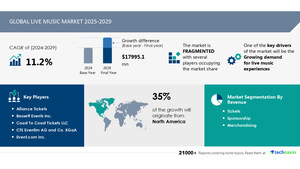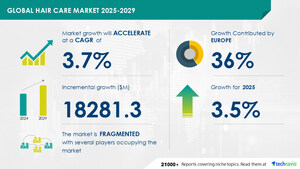NEW YORK, March 5, 2024 /PRNewswire/ -- The global synthetic biology market size is estimated to grow by USD 28.25 billion from 2022 to 2027, according to Technavio. The market is estimated to grow at a CAGR of 25.6% during the forecast period. The evolving regulatory framework around synthetic biology is a key trend in the market. Governments of various countries are working on developing standard guidelines, clear policies, and stringent regulations to tackle the risks associated with synthetic biology. For instance, in the US, the Toxic Substances Control Act (TSCA) deals with the potential impact of synthetic biology in human health and the environment. Europe also has numerous policies at international, community, member state, and local levels. Therefore, the evolving regulatory framework for synthetic biology is expected to promote investments, foster innovation, and ensure the safety and efficacy of synthetic biology products, which, in turn, will support market growth during the forecast period.
For more insights on the historic data (2017 to 2021) and forecast market size (2023 to 2027)
Segment overview
Technavio has segmented the market based on application (healthcare, industrial, food and agriculture, and others) and product (oligonucleotides, enzymes, cloning technology kits, xeno-nucleic acids, and chassis organism).
- The healthcare segment will account for a significant share of the market growth during the forecast period. It is used to create engineered systems of genes and other molecular components. Clinical applications of it are expected to expand further in the next few years. For instance, professors at the Massachusetts Institute of Technology (MIT) have developed a paper that has embedded modified genetic machinery from a cell. These factors will drive the growth of this segment during the forecast period.
- Based on geography, the global market is segmented into North America, Europe, Asia, and Rest of World (ROW). The report provides actionable insights and estimates the contribution of all regions to the growth of the global market. North America is estimated to account for 42% of the growth of the global market during the forecast period. The US and Canada are the key countries in the regional market. The demand for it is expected to increase owing to factors such as rising investments in companies, increasing demand for bio-based products, and growing R&D funding. In addition, governments in the region are focusing on the development of personalized therapeutics. Thus, increasing support from government and private institutions is expected to drive the growth of the market in the region during the forecast period.
The growing applications of synthetic biology
It helps improve the efficiency of products such as biochemicals, therapeutics, medicine, biofuels, and other bio-based substitutes. It can also be used in industries such as agriculture and F&B. For example, synthetic technology can be used to increase yield by enhancing properties such as efficient use of water and nutrients, nitrogen fixation and better resistance to pests, and photosynthetic performance.
- Technical challenges may impede the market growth.
Insights on the market contribution of various segments, including country- and region-wise historic data (2017 to 2021) and forecast market size (2023 to 2027)
Analyst Review
Synthetic biology stands at the forefront of innovation, revolutionizing various sectors with its transformative potential. At its core lies the manipulation of synthetic organisms and synthetic microbes, enabling the precise engineering of genetic material through genome editing. This capability has sparked immense interest across diverse domains, from healthcare to agriculture, prompting significant investments from pharmaceutical and biotech companies and governmental agencies alike.
Within the healthcare sector, it is catalyzing groundbreaking advancements in treating chronic and debilitating disorders such as cancer and HIV. Through targeted interventions leveraging gene editing technology, researchers are developing novel therapies to combat these ailments. Moreover, in the fight against antibiotic-resistant superbugs, it offers promising solutions, bolstering the antibiotic pipeline with innovative approaches.
In parallel, the agricultural sector is witnessing a paradigm shift driven by it. By harnessing synthetic and genetically modified organisms, researchers are enhancing crop yields and fortifying plants against environmental stressors. This convergence of biological and biotechnological domains underscores the far-reaching impact of it on global food security.
Machine learning and artificial intelligence (AI) play pivotal roles in advancing it, facilitating the design of complex genetic circuits and predictive modeling. This synergy empowers researchers to optimize cloning technology kits and streamline PCR workflows, enabling rapid prototyping and characterization of engineered organisms.
The emergence of bio-foundries and collaborative initiatives like SynbiCITE and SynBioVen further accelerates innovation in it. These platforms provide researchers with access to state-of-the-art infrastructure and foster interdisciplinary collaboration, propelling the field forward.
However, amidst the excitement surrounding it, biosafety, biosecurity, and ethical concerns remain paramount. Safeguarding against unintended consequences and ensuring responsible stewardship of synthetic cells and xeno-nucleic acids are critical imperatives.
Looking ahead, the market is poised for exponential growth, fueled by increasing demand across medical applications, industrial applications, food & agriculture, and environmental applications segments. With players like Creative Biogene driving innovation, the landscape of it continues to evolve, promising a future defined by unparalleled possibilities and transformative impact.
Related Reports:
The rapid microbiology testing market is estimated to grow at a CAGR of 9.31% between 2022 and 2027. The size of the market is forecasted to increase by USD 2,487.91 million.
The microbiology testing market is estimated to grow at a CAGR of 9.98% between 2022 and 2027. The size of the market is forecasted to increase by USD 3,012.8 million.
TOC
- Executive Summary
- Market Landscape
- Market Sizing
- Historic Market Size
- Five Forces Analysis
- Market Segmentation by Application
- market Segmentation by Product
- Customer Landscape
- Geographic Landscape
- Drivers, Challenges, and Trends
- Company Landscape
- Company Analysis
- Appendix
About US
Technavio is a leading global technology research and advisory company. Their research and analysis focus on emerging market trends and provide actionable insights to help businesses identify market opportunities and develop effective strategies to optimize their market positions. With over 500 specialized analysts, Technavio's report library consists of more than 17,000 reports and counting, covering 800 technologies, spanning across 50 countries. Their client base consists of enterprises of all sizes, including more than 100 Fortune 500 companies. This growing client base relies on Technavio's comprehensive coverage, extensive research, and actionable market insights to identify opportunities in existing and potential markets and assess their competitive positions within changing market scenarios.
Contact
Technavio Research
Jesse Maida
Media & Marketing Executive
US: +1 844 364 1100
UK: +44 203 893 3200
Email: [email protected]
Website: www.technavio.com/
SOURCE Technavio

WANT YOUR COMPANY'S NEWS FEATURED ON PRNEWSWIRE.COM?
Newsrooms &
Influencers
Digital Media
Outlets
Journalists
Opted In





Share this article